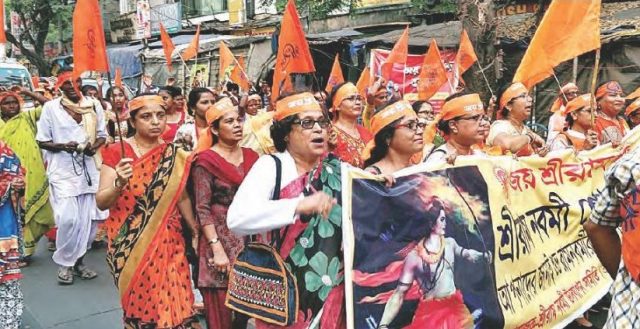
Unprecedented response to Shri Ram Navami celebration breaks all records as over 22 lakh people, including 4 lakh women joined
“The overwhelming excitement about Ram Navami in West Bengal is a matter of serious concern,” opines a left liberal columnist in a front page write up in a Bengali daily. “This is neither devotional nor religious, its political!”
The experience was really amazing. It was really a mega socio-political event for Bengali Hindus in the state. The enthusiasm of youth was not merely devotion, the contributory participation of the entire society can hardly be tagged as a religious ritual, it was a different extravaganza altogether. The most symbolic and synergic response came from women and so-called Dalit society. Thousands of girls and women from 16 to 60 years participated, contributed and even led the rallies. Troops of girls, dancing devotional Rabindra Nitya in front of Ram Darbar tableaux, women in white saree with red border blowing conch shell in rallies, elders producing Ulu dhawani (traditional Bengali Hindu vocal hooting sound)—a heavenly environment, indeed it was not a devotional ritualistic outfit.
In Purulia, Bankura, Alipurduar and Midnapur districts, Vanvasis came out with their traditional musical instruments, Dhamsa and Madal, performed “Chhou dance” on the street. The villages, urban areas, district cities and metros were flooded with slogans like, “Ek hi nara, ek hi nam/Jai Shri Ram, Jai Shri Ram”. People participated from all communities, social status, crossing the political barriers. Trinamool Congress supporters openly participated in the rallies. In North Bengal left party supporters including a considerable number of leaders in ranks also walked in the rallies. In Naxalbari, the contributory participation of former Panchayat Pradhan, local committee members of the Left Front parties would definitely be noteworthy.
This year, Ram Navami celebration in the state was the biggest of all time. On the eve of 16th century Shri Chaitanya Mahaprabhu introduced “Nagar Sankirtan” in Bengal. Chaitanya organised Nagar Sankirtan and marched to the palace of Chand Kazi, where he obtained the permission for public Sankirtan from Kazi. Nagar Sankirtan was neither merely devotional nor simply religious; it was a revolutionary act, which saved Bengal from becoming Afghanistan.
Beyond Religious Rituals
Krittibashi Ramayan, one of the old translations of Sanskrit Ramayan, was composed in 14th century by Krittibus Ojha of Nadia District. Durgapuja, the biggest festival of Bengalis is performed to commemorate the “Akalbodhan (untimely invoking) of Devi Durga” by Shri Ramchandra before attacking Lanka. ‘Raghubeer’ was the family deity of Shri Ramakrishna Paramahansa. Swami Bramhananda introduced daily enchanting of ‘Ramdhun’ in every Ramakrishna Mission Ashrams all over the country. S Wajed Ali, in his story “Bharatbarsha” narrates how Bengali tradition is emotionally attached with the teachings of Ramayana. Ironically left liberal intellects consider Ram as non-Bengali culture and last year in all Bengali dailies they criticised RSS-BJP for importing Ram Navami from north India. As per their version, “Ram Navami doesn’t go with Bengali tradition and culture!”
They didn’t have any objection against communal outfits against Tasleema, Khagragarh blast in 2015, Kaliachak riots in 2016 or Dhulagarh in 2017. None of the so-called ‘eminent progressive intellectuals’ spelled a single word against these deadly incidents, their reservation is only with Ram Navami. Nevertheless, the common people of West Bengal have proved them wrong as this year their participation was much more than last time. As per the available data, about 22 lakh Hindus participated, among them about four lakh participants were women. Even the toughest critics have noticed the active participation of working class in all the rallies.
How the Steel was Tampered
Initially, the ruling Trinamool Congress ignored the resurgence of Bengali Hindus. But this time they sensed the Hindu solidarity and engaged their “Kattappas” to tame the Hindu forces. Arjun Singh, a listed criminal in the record of local Police Station, has become TMC maseeha of Knakinara-Bhattpara locality. Arjun’s men threatened the local Hindu leaders and asked them not to participate in Ram Navami rally. Vishwa Hindu Parishad, Jagaddal unit arranged a blood donation camp on March 18 in connection with Ram Navami celebration. Arjun’s group vandalised the programme and asked the organisers not to participate in Ram Navami.
Ranigunj: A big rally was organised by VHP and other organisations on March 26, following all directives of the local administration. None of the participants was carrying any kind of weapon. The procession was passing through Rajabnadh area fundamentalist elements started throwing stones. After few minutes the goons started bombing. Police tried to control the attackers. Arindam Duttachowdhury lost his right hand due to bomb blast. Communal goons killed Mahesh Monal (50) and VHP activist is seriously injured.
Purulia: The procession was attacked by Md. Selim, Trinamool Congress Sah Sabhapati, Beldi block of Purulia district on March 25.
Kandi: Anupam, office bearer of Trinamool Yuva Congress tried to vandalise the procession at Kandi in Mushidabad.
Asansol: The rally was attacked by the goons led by TMC leaders on March 27. They attacked the processions without any provocation.
Unfit to Govern
Hindus were told not to carry weapons in processions. But last year TMC MP Kalyan Banerjee exhibited sword during Muharram procession. Local residents lodged complaint against the leader in Chapdani Police Station of Hoogly District. No action has yet been taken by West Bengal police. This time some political leaders, including TMC MLA Arjun Singh carried traditional weapons in Ram Navami procession.
By Jisnu Basu
Courtesy: Organiser














